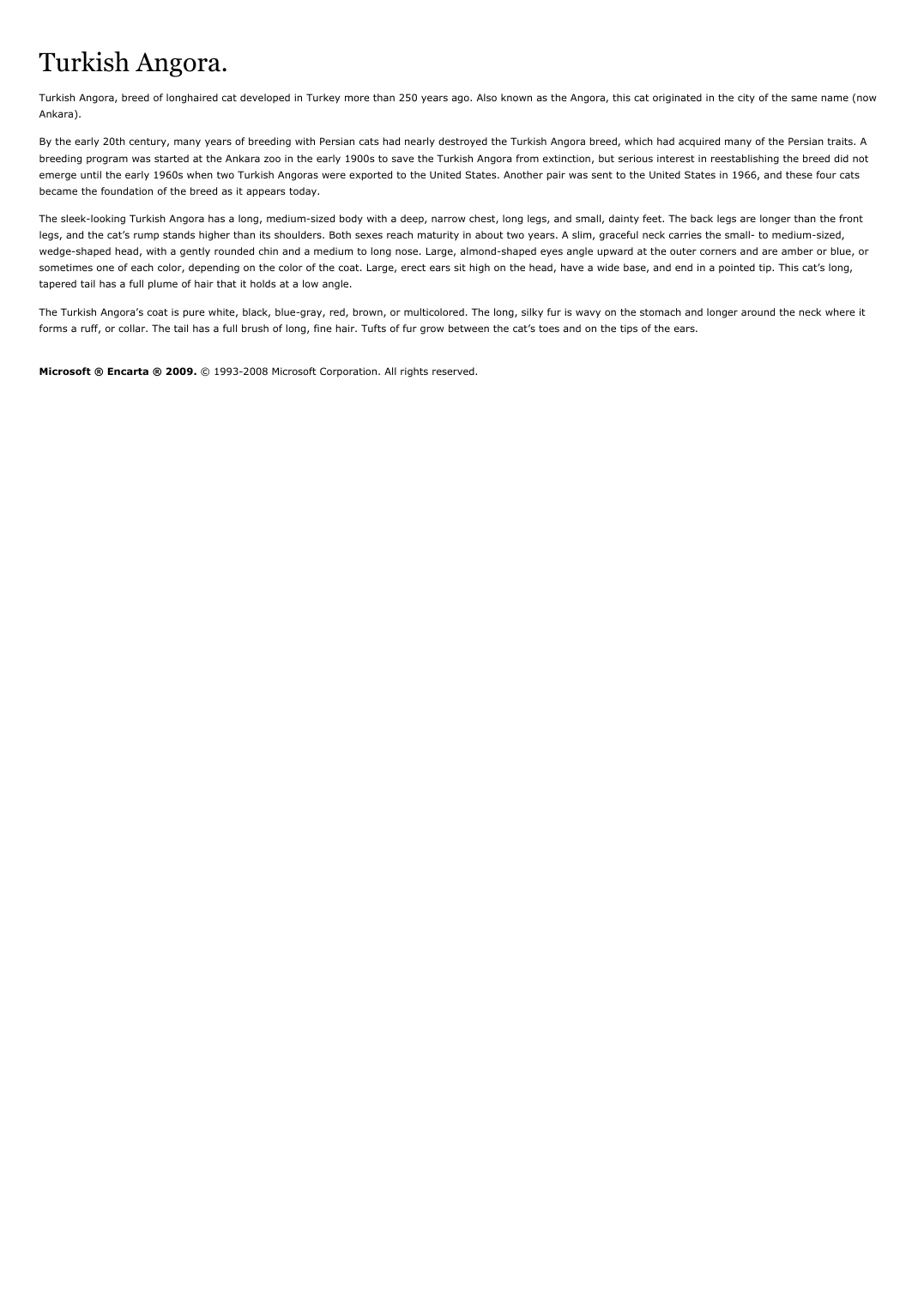Turkish Angora.
Publié le 06/12/2021
Extrait du document
Ci-dessous un extrait traitant le sujet : Turkish Angora.. Ce document contient 330 mots. Pour le télécharger en entier, envoyez-nous un de vos documents grâce à notre système d’échange gratuit de ressources numériques ou achetez-le pour la modique somme d’un euro symbolique. Cette aide totalement rédigée en format pdf sera utile aux lycéens ou étudiants ayant un devoir à réaliser ou une leçon à approfondir en : Echange
Turkish Angora.
Turkish Angora, breed of longhaired cat developed in Turkey more than 250 years ago. Also known as the Angora, this cat originated in the city of the same name (now
Ankara).
By the early 20th century, many years of breeding with Persian cats had nearly destroyed the Turkish Angora breed, which had acquired many of the Persian traits. A
breeding program was started at the Ankara zoo in the early 1900s to save the Turkish Angora from extinction, but serious interest in reestablishing the breed did not
emerge until the early 1960s when two Turkish Angoras were exported to the United States. Another pair was sent to the United States in 1966, and these four cats
became the foundation of the breed as it appears today.
The sleek-looking Turkish Angora has a long, medium-sized body with a deep, narrow chest, long legs, and small, dainty feet. The back legs are longer than the front
legs, and the cat's rump stands higher than its shoulders. Both sexes reach maturity in about two years. A slim, graceful neck carries the small- to medium-sized,
wedge-shaped head, with a gently rounded chin and a medium to long nose. Large, almond-shaped eyes angle upward at the outer corners and are amber or blue, or
sometimes one of each color, depending on the color of the coat. Large, erect ears sit high on the head, have a wide base, and end in a pointed tip. This cat's long,
tapered tail has a full plume of hair that it holds at a low angle.
The Turkish Angora's coat is pure white, black, blue-gray, red, brown, or multicolored. The long, silky fur is wavy on the stomach and longer around the neck where it
forms a ruff, or collar. The tail has a full brush of long, fine hair. Tufts of fur grow between the cat's toes and on the tips of the ears.
Microsoft ® Encarta ® 2009. © 1993-2008 Microsoft Corporation. All rights reserved.
Turkish Angora.
Turkish Angora, breed of longhaired cat developed in Turkey more than 250 years ago. Also known as the Angora, this cat originated in the city of the same name (now
Ankara).
By the early 20th century, many years of breeding with Persian cats had nearly destroyed the Turkish Angora breed, which had acquired many of the Persian traits. A
breeding program was started at the Ankara zoo in the early 1900s to save the Turkish Angora from extinction, but serious interest in reestablishing the breed did not
emerge until the early 1960s when two Turkish Angoras were exported to the United States. Another pair was sent to the United States in 1966, and these four cats
became the foundation of the breed as it appears today.
The sleek-looking Turkish Angora has a long, medium-sized body with a deep, narrow chest, long legs, and small, dainty feet. The back legs are longer than the front
legs, and the cat's rump stands higher than its shoulders. Both sexes reach maturity in about two years. A slim, graceful neck carries the small- to medium-sized,
wedge-shaped head, with a gently rounded chin and a medium to long nose. Large, almond-shaped eyes angle upward at the outer corners and are amber or blue, or
sometimes one of each color, depending on the color of the coat. Large, erect ears sit high on the head, have a wide base, and end in a pointed tip. This cat's long,
tapered tail has a full plume of hair that it holds at a low angle.
The Turkish Angora's coat is pure white, black, blue-gray, red, brown, or multicolored. The long, silky fur is wavy on the stomach and longer around the neck where it
forms a ruff, or collar. The tail has a full brush of long, fine hair. Tufts of fur grow between the cat's toes and on the tips of the ears.
Microsoft ® Encarta ® 2009. © 1993-2008 Microsoft Corporation. All rights reserved.
↓↓↓ APERÇU DU DOCUMENT ↓↓↓

































